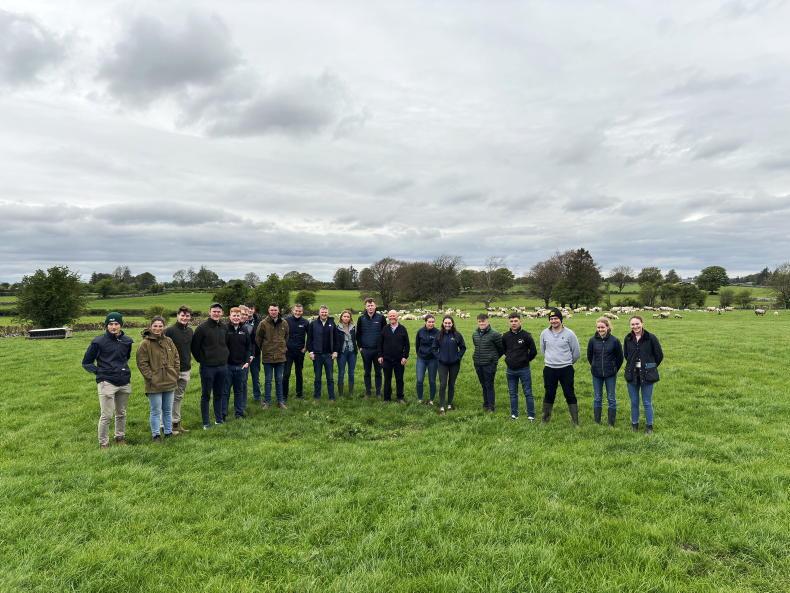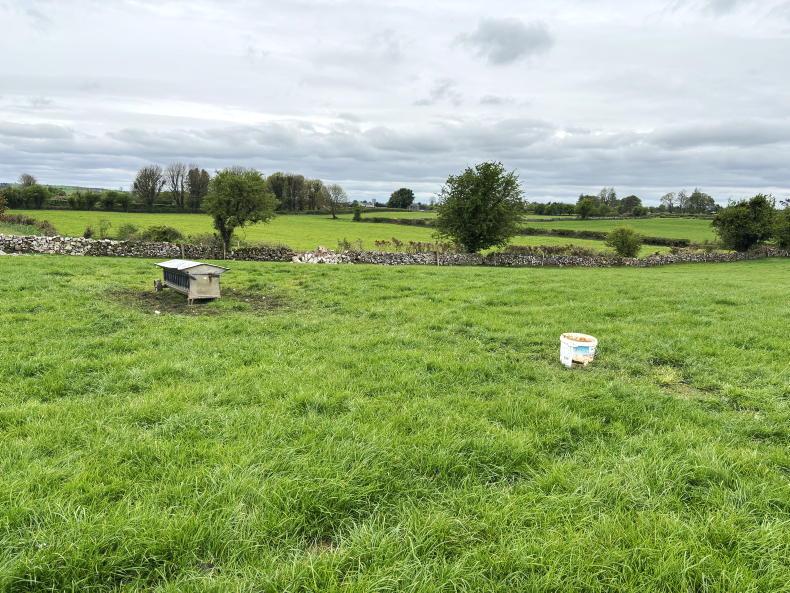The first of the Kepak Young Sheep Farmer forum meetings took place in recent weeks in Co Roscommon; a fitting place to begin, what with a sheep featuring proudly on the county flag.
The forum brings together 13 young farmers from different educational backgrounds across Ireland to form a discussion group. Meeting monthly from April to September 2025, participants will explore the full sheep market – from farm to fork. Highlights of the programme include:
On-farm workshops and site visits: Learn best practices with visits to research centres like Teagasc, as well as commercially viable enterprises.Industry insights: Gain first-hand exposure to international perspectives with a visit to Bord Bia offices and Rungis – the largest market in France where Kepak supplies lamb.Policy influence: Collaborate on farm-focused recommendations aimed at informing the Government’s Budget 2026.Some of the key challenges facing Irish sheep farming are declining flock numbers, an aging demographic, and rising environmental and market challenges, all of which the forum aims to address.
Visit 1: Kepak, Athleague
To kick off the day, the cohort of young shepherds met at Kepak Athleague. The Athleague plant is a major processing facility for beef and lamb for the company in Ireland, with a history dating back to the 1980s.
Kepak Athleague employs 320 staff and sources from over 8,000 local beef and lamb farmers, and, due to its location in the west of Ireland, kills a huge volume of lambs, hoggets and ewes each year.
Visit 2: Willie John and James Fitzmaurice
Willie John and his son James farm in partnership together just five minutes outside the village of Athleague.
The duo run a spring calving suckler herd alongside the lowland ewe flock, where small changes to breeding policy and grassland management have played dividends to the operation.

Young Sheep Farmer forum Kepak first walk at the farm of Willie John and James Fitzmaurice, Athleague.
Ewes lamb from mid-February onwards and are all lambed outdoors to cut down on infrastructure and labour costs. Ewes are drafted every two days during the lambing period, where those most likely to lamb are then placed in the most sheltered field on the farm.
Ewe choice is predominantly Suffolk and Texel-cross with Texel and Beltex rams used across the flock. Lambs are creep fed from six weeks of age, with Willie John highlighting the feed efficiency at a young age, the reduced labour and cost of dosing and lameness management with a more rapid finishing period and the greater availability of grass for ewes going back to the ram in autumn as some of the main reasons for this.

Ewes and lambs on the Fitzmaurice farm. Over 40% of lambs slaughtered in 2024 killed E-grade.
Ten per cent of the farm is reseeded annually, something that James highlights as being a necessity to have sufficient winter growth to keep ewes outdoors, while James also tracks the output performance of the flock on a yearly basis on a simple excel sheet.
Fields are subdivided with temporary fencing, with ewes moved on every three-five days to fresh grass.
It’s clear to see that the farm is making strides in driving efficiency, with 4% of lambs killing E grade in 2021 rising to 42% last year, while no R-grading lamb was killed in 2024.
Some of Willie John and James’s key advice
Farm your own land. Do whatever enterprise or system suits your farm best, and don’t chop and change regularly. Stick with a system.The cheque for lambs isn’t everything, it’s the profit you make from them.Have a social outlet; join Macra or your local show committee or other organisations.A good dog is one of the most useful tools; get them trained and get yourself trained on how to use them.Target larger ram sales for more choice. Open-chested (wool) Texels tend to be easier fleshed in their opinion.Noel farms part-time on the Galway border, operating a 100-ewe flock across 50 acres. Again, the flock performs exceptionally well, with a scanning rate of 1.99 recorded in 2024 improved upon this year with a scan rate of 2.04. Ewes are house at New Year, segregated according to litter size and fed accordingly.
Due to the high number of triplets, wet fostering on to single-bearing ewes is necessary – the ewes are fed to have sufficient milk at lambing to take a second lamb.
Combining the impressive scan result is a more impressive mortality rate of 3%, while this year, eight of the 16 ewes who scanned with triplets are rearing them.
Creep feed is also utilised, with the mid-season flock seeing lambs drafted from June 10 at 44-45kg liveweight, with two bags of concentrates required on average to finish a lamb. Eighty per cent of lambs are drafted by August 1.
All lambs receive powdered colostrum at birth and their navels disinfected. While replacements are generally bought in, the high cost in recent years has seen Noel mark 25 ewe lambs to retain as replacements for himself.
Noel’s key advice:
Keep things simple; fancy machinery is not a necessity for sheep farming.Ewe BCS plays a huge factor in profitability; from litter size to milking ability to longevity.The higher the age profile of the flock, the higher the litter size. Keep ewes in good order and they will last up to six or seven crops.
Young Sheep Farmer forum Kepak first walk at the farm of Willie John and James Fitzmaurice, Athleague discussing grasssland management.

Lambs are creep fed from six weeks, while ewes receive only mineral licks post lambing on the Fitzmaurice farm.
The first of the Kepak Young Sheep Farmer forum meetings took place in recent weeks in Co Roscommon; a fitting place to begin, what with a sheep featuring proudly on the county flag.
The forum brings together 13 young farmers from different educational backgrounds across Ireland to form a discussion group. Meeting monthly from April to September 2025, participants will explore the full sheep market – from farm to fork. Highlights of the programme include:
On-farm workshops and site visits: Learn best practices with visits to research centres like Teagasc, as well as commercially viable enterprises.Industry insights: Gain first-hand exposure to international perspectives with a visit to Bord Bia offices and Rungis – the largest market in France where Kepak supplies lamb.Policy influence: Collaborate on farm-focused recommendations aimed at informing the Government’s Budget 2026.Some of the key challenges facing Irish sheep farming are declining flock numbers, an aging demographic, and rising environmental and market challenges, all of which the forum aims to address.
Visit 1: Kepak, Athleague
To kick off the day, the cohort of young shepherds met at Kepak Athleague. The Athleague plant is a major processing facility for beef and lamb for the company in Ireland, with a history dating back to the 1980s.
Kepak Athleague employs 320 staff and sources from over 8,000 local beef and lamb farmers, and, due to its location in the west of Ireland, kills a huge volume of lambs, hoggets and ewes each year.
Visit 2: Willie John and James Fitzmaurice
Willie John and his son James farm in partnership together just five minutes outside the village of Athleague.
The duo run a spring calving suckler herd alongside the lowland ewe flock, where small changes to breeding policy and grassland management have played dividends to the operation.

Young Sheep Farmer forum Kepak first walk at the farm of Willie John and James Fitzmaurice, Athleague.
Ewes lamb from mid-February onwards and are all lambed outdoors to cut down on infrastructure and labour costs. Ewes are drafted every two days during the lambing period, where those most likely to lamb are then placed in the most sheltered field on the farm.
Ewe choice is predominantly Suffolk and Texel-cross with Texel and Beltex rams used across the flock. Lambs are creep fed from six weeks of age, with Willie John highlighting the feed efficiency at a young age, the reduced labour and cost of dosing and lameness management with a more rapid finishing period and the greater availability of grass for ewes going back to the ram in autumn as some of the main reasons for this.

Ewes and lambs on the Fitzmaurice farm. Over 40% of lambs slaughtered in 2024 killed E-grade.
Ten per cent of the farm is reseeded annually, something that James highlights as being a necessity to have sufficient winter growth to keep ewes outdoors, while James also tracks the output performance of the flock on a yearly basis on a simple excel sheet.
Fields are subdivided with temporary fencing, with ewes moved on every three-five days to fresh grass.
It’s clear to see that the farm is making strides in driving efficiency, with 4% of lambs killing E grade in 2021 rising to 42% last year, while no R-grading lamb was killed in 2024.
Some of Willie John and James’s key advice
Farm your own land. Do whatever enterprise or system suits your farm best, and don’t chop and change regularly. Stick with a system.The cheque for lambs isn’t everything, it’s the profit you make from them.Have a social outlet; join Macra or your local show committee or other organisations.A good dog is one of the most useful tools; get them trained and get yourself trained on how to use them.Target larger ram sales for more choice. Open-chested (wool) Texels tend to be easier fleshed in their opinion.Noel farms part-time on the Galway border, operating a 100-ewe flock across 50 acres. Again, the flock performs exceptionally well, with a scanning rate of 1.99 recorded in 2024 improved upon this year with a scan rate of 2.04. Ewes are house at New Year, segregated according to litter size and fed accordingly.
Due to the high number of triplets, wet fostering on to single-bearing ewes is necessary – the ewes are fed to have sufficient milk at lambing to take a second lamb.
Combining the impressive scan result is a more impressive mortality rate of 3%, while this year, eight of the 16 ewes who scanned with triplets are rearing them.
Creep feed is also utilised, with the mid-season flock seeing lambs drafted from June 10 at 44-45kg liveweight, with two bags of concentrates required on average to finish a lamb. Eighty per cent of lambs are drafted by August 1.
All lambs receive powdered colostrum at birth and their navels disinfected. While replacements are generally bought in, the high cost in recent years has seen Noel mark 25 ewe lambs to retain as replacements for himself.
Noel’s key advice:
Keep things simple; fancy machinery is not a necessity for sheep farming.Ewe BCS plays a huge factor in profitability; from litter size to milking ability to longevity.The higher the age profile of the flock, the higher the litter size. Keep ewes in good order and they will last up to six or seven crops.
Young Sheep Farmer forum Kepak first walk at the farm of Willie John and James Fitzmaurice, Athleague discussing grasssland management.

Lambs are creep fed from six weeks, while ewes receive only mineral licks post lambing on the Fitzmaurice farm.










 This is a subscriber-only article
This is a subscriber-only article










SHARING OPTIONS: